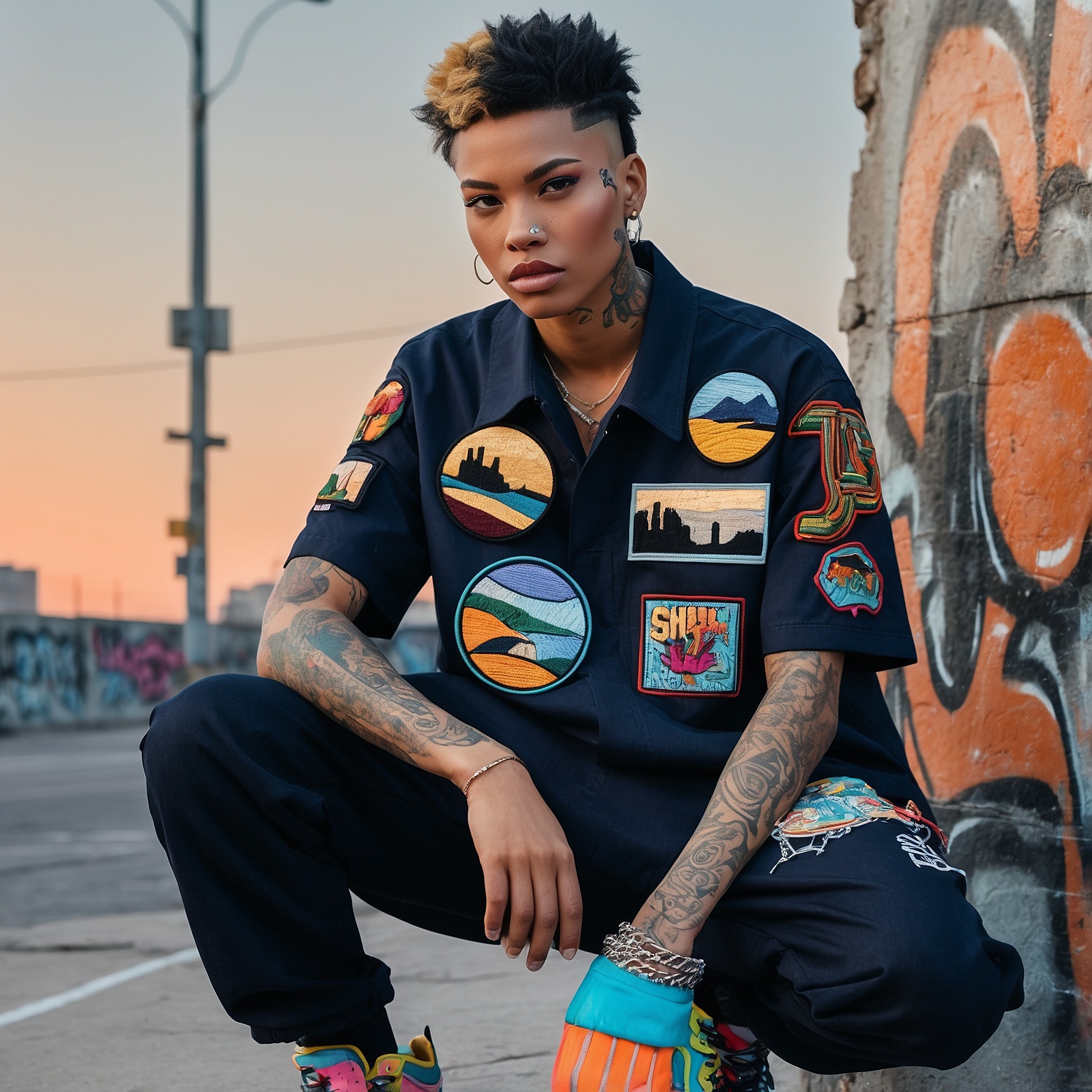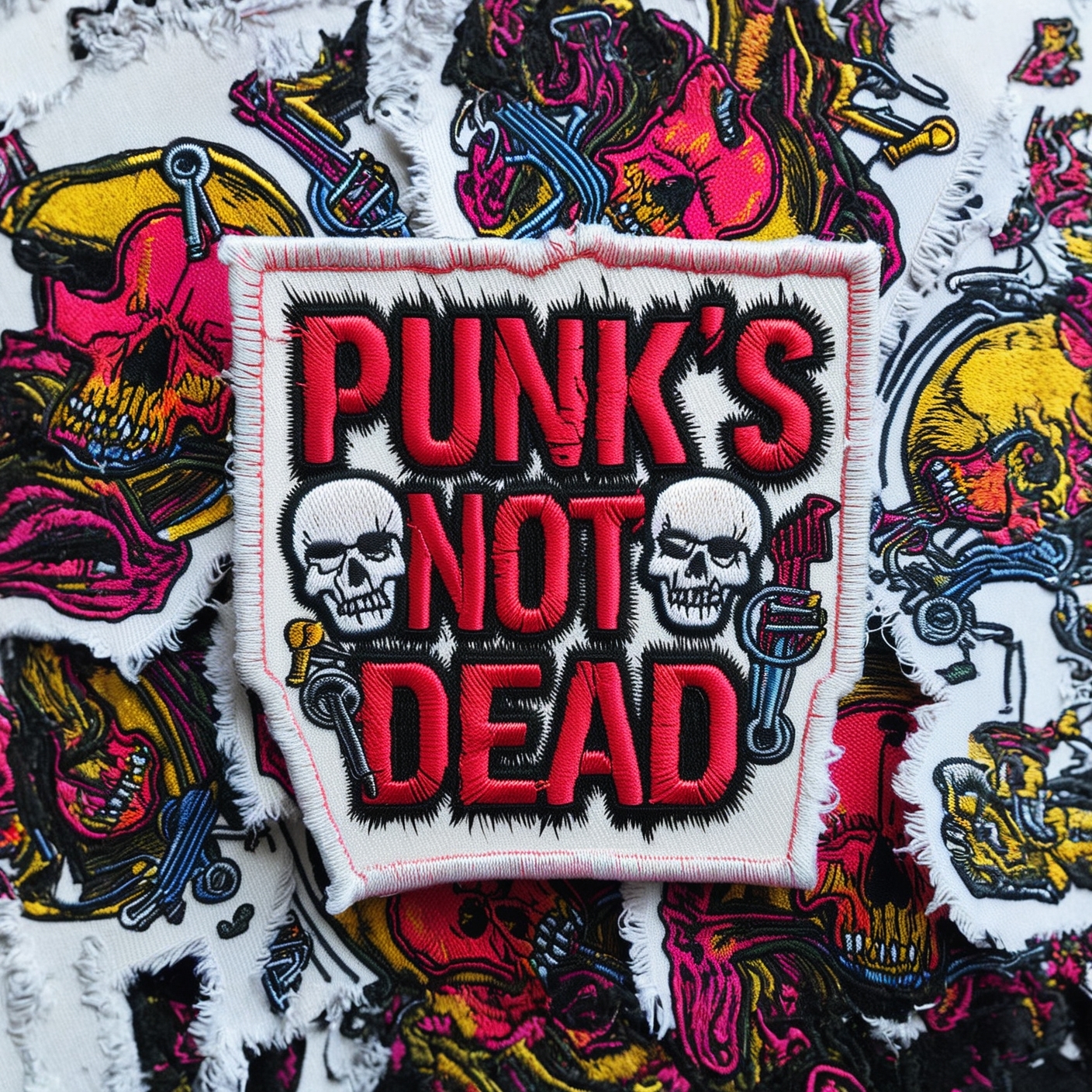Urban fashion is a dynamic, ever-evolving expression of individuality, culture, and rebellion. It thrives on personal style and the desire to stand out, which has led to the rise of customization as a hallmark of the urban fashion scene. From streetwear brands to independent designers and DIY fashion enthusiasts, customization allows wearers to express their identity, values, and unique aesthetic. One of the most popular mediums for this self-expression is the use of custom patches.
Custom patches have become a defining feature of urban fashion, offering an affordable, accessible, and visually striking way for individuals to personalize their clothing, accessories, and footwear. In the fast-paced world of streetwear, where trends can shift overnight, custom patches serve as a constant—allowing wearers to make bold statements, show affiliation with certain subcultures, and even participate in political or social movements through their clothing. These patches bridge the gap between fashion and personal storytelling, enabling designers and consumers to turn everyday garments into unique, wearable art.
In this article, we’ll explore how custom patches have shaped urban fashion, tracing their roots in counterculture movements, their growing prominence in the streetwear scene, and their continued evolution as tools for personal expression. From design inspiration to their cultural significance, we’ll dive into the ways custom patches continue to impact the fabric of the streets.
The Rise of Custom Patches in Urban Fashion
Custom patches have a long history of association with rebellion, identity, and cultural movements. While their origins are often traced back to military use and uniform insignias, custom patches eventually found their way into the civilian world—gaining popularity among biker gangs, punk rock bands, and other countercultural groups. Over time, their association with subcultures evolved, and they became a staple in streetwear, which thrives on the idea of non-conformity and individuality.
1. Roots in Counterculture and Rebellion
Custom patches first emerged as tools of identification in military units, but they quickly became symbols of defiance and identity in civilian life, especially during the mid-20th century. In the 1960s and 1970s, patches became synonymous with biker gangs and the punk rock scene, where they were used to display loyalty, affiliations, and anti-establishment sentiments.
- Biker Gangs: Patches were central to the identity of biker gangs like the Hells Angels, where they were used to indicate membership, rank, and achievements within the group. These patches were sewn onto leather jackets and vests, establishing a visual language that represented rebellion and brotherhood.
- Punk Rock Culture: In the punk movement, patches became an essential form of self-expression and DIY ethos. Punk rockers used patches to adorn their clothing with band logos, political slogans, and anarchist symbols, often stitching them onto torn jeans or leather jackets. These patches were not just about fashion—they were statements of anti-conformity and resistance against mainstream culture.
- Pro Tip: For urban fashion designers or DIY enthusiasts today, incorporating elements of rebellion or cultural commentary into custom patches can add depth to their designs. Drawing inspiration from these historic roots helps create patches that resonate with modern wearers seeking individuality.
2. Transition to Streetwear Culture
In the 1980s and 1990s, custom patches transitioned from their counterculture roots to become a defining feature of the emerging streetwear movement. Streetwear, born in the streets of New York and Los Angeles, drew inspiration from skateboarding, hip-hop, graffiti, and youth culture. As brands like Stüssy, Supreme, and BAPE began to rise, they brought custom patches into the mainstream of urban fashion.
- Skateboarding Culture: Skate culture played a pivotal role in integrating custom patches into streetwear. Skaters, known for their DIY aesthetic and preference for individuality, frequently adorned their clothing and gear with patches that featured brand logos, street art, and personal insignias. Patches became a way for skaters to claim their space and build their unique style.
- Hip-Hop and Graffiti: The hip-hop scene, particularly in the 1990s, embraced custom patches as a way to display pride in one’s neighborhood, crew, or favorite artists. Graffiti culture, with its emphasis on tagging and marking public spaces, found a new outlet in custom patches, which allowed graffiti artists to bring their designs into wearable fashion.
- Pro Tip: For brands looking to make a statement in the streetwear market, partnering with graffiti artists or other urban creatives to design custom patches can lead to innovative and culturally relevant designs that resonate with urban consumers.
Why Custom Patches Are Perfect for Urban Fashion
In the fast-paced world of streetwear and urban fashion, custom patches have proven themselves as a go-to medium for personalization and self-expression. Below are some reasons why custom patches continue to thrive in urban fashion:
1. Affordability and Accessibility
One of the key reasons custom patches have become so popular in urban fashion is their affordability. Compared to other forms of customization, such as embroidery or custom printing, custom patches offer a cost-effective way for individuals to modify their clothing and accessories without breaking the bank.
- Example: For a relatively low cost, streetwear enthusiasts can purchase custom patches and transform a plain hoodie or denim jacket into a personalized fashion statement. Patches can be easily sewn or ironed onto garments, giving wearers instant access to unique, one-of-a-kind designs.
- Pro Tip: Urban fashion brands can offer custom patches as part of their product line, allowing customers to personalize their purchases. This provides an interactive shopping experience and gives consumers more control over their style.
2. Versatility in Design
The versatility of custom patches makes them a perfect fit for streetwear, where creativity and experimentation are key. Patches come in various shapes, sizes, colors, and materials, allowing designers and wearers to experiment with different aesthetics and visual statements.
- Design Flexibility: From minimalist monochrome designs to vibrant, multi-colored graphics, custom patches can be tailored to match any style. Whether someone wants to showcase their favorite streetwear brand, promote a political cause, or simply add a touch of flair to their outfit, patches can be designed to suit their personal vision.
- Mixed Materials: Many urban fashion designers experiment with different materials for their custom patches. Leather, denim, felt, and even reflective or glow-in-the-dark fabrics are commonly used to create visually striking and functional patches.
- Pro Tip: For streetwear designers, using unconventional materials and bold color contrasts in custom patches can help set their brand apart and create a visually captivating product that appeals to trend-conscious consumers.
3. Easy Application and Customization
One of the biggest advantages of custom patches is their ease of application. With sew-on, iron-on, and Velcro-back options, patches can be added to a wide range of garments, accessories, and even footwear. This ease of customization has made patches particularly popular in urban fashion, where personalization is central to the wearer’s identity.
- Iron-On Patches: Iron-on patches are particularly popular among streetwear enthusiasts because they allow for quick, no-sew customization. Simply applying heat with an iron adheres the patch to the fabric, making it an ideal option for DIYers looking to customize their clothing.
- Sew-On Patches: For a more durable and long-lasting attachment, sew-on patches provide a secure way to customize jackets, jeans, and hats. This method ensures that patches remain in place, even after repeated wear and washing.
- Pro Tip: Urban fashion brands can offer customization services at pop-up shops or events, where consumers can choose and apply custom patches on-site. This creates an interactive experience that adds value to the brand and enhances customer engagement.
4. Patches as Symbols of Identity and Affiliation
In urban fashion, clothing is more than just what people wear—it’s a way to communicate identity, values, and affiliations. Custom patches play a crucial role in helping wearers express their personal stories, passions, and loyalties. Whether they’re part of a specific subculture or simply looking to show pride in their hometown, patches allow individuals to broadcast their affiliations to the world.
- Political and Social Statements: Many streetwear brands and independent designers use custom patches to make bold statements about political or social issues. These patches might feature slogans related to activism, social justice, or environmentalism, allowing wearers to use fashion as a platform for their beliefs.
- Subcultural Identity: Custom patches also provide a way for wearers to show affiliation with specific subcultures, such as skaters, hip-hop enthusiasts, or graffiti artists. Patches featuring the logos of underground brands, niche music scenes, or street art collectives help individuals display their loyalties and make connections with others who share their interests.
- Pro Tip: For independent designers or streetwear brands, partnering with social causes or activist movements to create custom patches can lead to designs that resonate deeply with consumers while supporting meaningful initiatives.
The Evolution of Custom Patches in Modern Urban Fashion
As urban fashion continues to evolve, custom patches have adapted to fit new styles, technologies, and cultural influences. Designers today are pushing the boundaries of what custom patches can be, experimenting with everything from high-tech materials to collaborations with artists and celebrities.
1. High-Tech Materials and Digital Designs
The integration of new technologies and materials into fashion has opened up exciting possibilities for custom patches. Today, designers are incorporating elements like reflective fabrics, glow-in-the-dark threads, and even smart textiles into their patch designs, creating futuristic patches that merge fashion with functionality.
- Reflective Patches: Reflective materials, often used in athletic wear, have found their way into custom patches in urban fashion. These patches not only add a unique visual element but also provide safety benefits, making wearers more visible in low-light conditions—an ideal feature for bikers and pedestrians in urban environments.
- Glow-in-the-Dark Patches: Glow-in-the-dark threads or paints can be used to create patches that come alive at night. These patches add an element of surprise, transforming otherwise simple designs into eye-catching pieces once the lights go out.
- Pro Tip: For designers looking to create innovative, tech-infused patches, experimenting with smart textiles or integrating LED lights into patch designs could offer a futuristic edge that appeals to tech-savvy consumers.
2. Collaborations with Artists and Influencers
Streetwear thrives on collaboration, with many of the most successful brands partnering with artists, musicians, and influencers to create limited-edition collections. Custom patches offer an exciting medium for these collaborations, allowing artists and designers to bring their visions to life in a tangible, wearable format.
- Artist Collaborations: Urban fashion brands often collaborate with graffiti artists, tattoo artists, or illustrators to create unique patch designs that reflect both the brand’s identity and the artist’s style. These limited-edition patches are highly collectible and can quickly become statement pieces in the streetwear community.
- Influencer Merchandising: Social media influencers and celebrities have also embraced custom patches as part of their merchandising strategies. Influencers with strong personal brands can create custom patches that resonate with their followers, offering them a piece of wearable art that connects them to the influencer’s message or persona.
- Pro Tip: Urban fashion brands should consider working with up-and-coming artists or influencers to co-create custom patches that blend street style with art or music culture. This creates hype around the product and introduces the brand to new audiences.
3. Streetwear Brands and DIY Fashion Communities
While major streetwear brands have embraced custom patches as part of their collections, DIY fashion communities continue to play a pivotal role in the patch culture. Independent designers, crafters, and DIY enthusiasts use patches to transform vintage clothing, thrifted finds, or simple garments into one-of-a-kind pieces. This grassroots approach to fashion is what keeps the patch scene thriving in urban culture.
- DIY Customization: For many streetwear enthusiasts, part of the appeal of custom patches is the opportunity to participate in DIY customization. By collecting patches from local designers or creating their own, fashion lovers can experiment with different looks and refresh their wardrobe without needing to purchase new items.
- Upcycling and Sustainability: As sustainability becomes more important in fashion, many urban designers are using custom patches to upcycle old or damaged clothing. Adding patches to torn jeans, worn-out jackets, or faded hats not only gives these garments new life but also promotes sustainable fashion practices.
- Pro Tip: For designers interested in sustainability, marketing custom patches as a way to upcycle or refresh old clothing can appeal to eco-conscious consumers looking for creative, low-waste fashion solutions.
Cultural Significance of Custom Patches in Urban Fashion
Beyond their aesthetic appeal, custom patches carry deep cultural significance in urban fashion. They serve as symbols of resistance, identity, and solidarity within various subcultures, providing a visual language through which wearers communicate their place in the world.
1. Patches as Protest and Social Commentary
Throughout history, fashion has been a powerful medium for protest and social commentary, and custom patches are no exception. From the punk rock era to today’s political streetwear, patches have been used to make bold statements about everything from government oppression to environmental activism.
- Political Patches: Many modern custom patches feature political slogans, symbols, or artwork that reflect the wearer’s stance on social justice issues. In the age of social media, these patches often go viral, turning everyday clothing into a form of wearable protest that sparks conversations both online and offline.
- Pro Tip: Designers interested in activism or social justice can create custom patches that reflect current issues, offering consumers a way to visually support the causes they care about while participating in the larger conversation surrounding these movements.
2. Streetwear as a Tool for Identity Expression
In urban environments, where diverse cultures intersect, clothing is a key tool for expressing identity. Custom patches allow individuals to represent their cultural heritage, neighborhood pride, or affiliation with a specific music scene or street sport.
- Cultural Heritage Patches: Many streetwear brands and designers use custom patches to celebrate cultural heritage. Whether featuring traditional patterns, flags, or symbols from different ethnic backgrounds, these patches allow wearers to showcase pride in their roots while staying true to urban fashion trends.
- Pro Tip: For designers interested in blending culture and streetwear, creating custom patches that reflect diverse cultural influences can appeal to consumers who want to showcase their heritage through fashion.
3. Patches as Markers of Achievement and Status
In some urban subcultures, custom patches are used as markers of achievement or status. Much like the biker gangs of the past, streetwear enthusiasts may use patches to showcase their dedication to a particular brand, movement, or community.
- Exclusive Drops and Limited Editions: Streetwear brands often release custom patches as part of exclusive drops or limited-edition collections. These patches become highly coveted and sought-after, with wearers using them to signal their connection to specific brands or cultural movements.
- Pro Tip: Releasing limited-edition custom patches as part of a brand’s product line creates a sense of urgency and exclusivity, driving interest and demand from consumers who want to be part of the brand’s inner circle.
Custom Patches as the Fabric of the Streets
In the world of urban fashion, custom patches have evolved from simple badges of affiliation to powerful symbols of identity, creativity, and rebellion. They offer a unique way for individuals to personalize their clothing, express their cultural values, and make bold statements about the world around them. As streetwear continues to push the boundaries of fashion, custom patches will remain a key tool for designers and wearers alike, serving as both fashion statements and cultural artifacts.
From their roots in counterculture movements to their modern-day resurgence in streetwear, custom patches have left an indelible mark on urban fashion. As long as fashion remains a means of self-expression, these patches will continue to stitch stories of identity, affiliation, and advocacy into the fabric of the streets. If you are interested in ordering some high-quality custom patches, feel free to call us at 877-912-6407 or fill out a FREE quote here.



